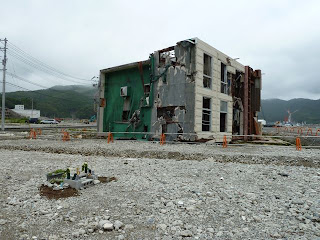***Disclaimer: Please note these posts are retold as interpreted. They also reflect my own personal views and opinions and not those of the seminar, its professors and lecturers, or affiliations. In addition, these photos and stories can be quite tragic and gut-wrenching, so proceed at your own risk. Some of these photos I did not watermark, because I feel it would be a good thing to pass them on.***
On our second day, we visited Onagawa, another town devastated by the March 2011 earthquake and tsunami.
The sight was eerily familiar - it was mountains after mountains of debris.
These are called debris, but take a closer look at them and you will see remnants of people's lives.
The closer we came to the coast, the more haunting the sight of the town that was once there.
If you can believe it, there used to be a bustling town here, Onagawa.
This was where the town center used to be.
The only building that is still there now is this uprooted apartment building, which was left alone as a memorial. Next to it is a small gravestone in memory of the lives lost here.
The (middle) building atop this hill is the town hospital, which is 3 stories high. The tsunami washed over this hill and submerged the first floor of this hospital. Use that bus as a point of reference - it was a colossal wave. Those who survived escaped it by climbing up the roof of the hospital.
The grass says "We love Onagawa."
Next we visited a small cluster of shops made out of donated freight containers, meant to help local small businesses get back on their feet. One NPO donated the containers, another brought in a team of carpenters to build this beautiful outer shed.
Inside the shed, you can see how the freight containers were reframed and refashioned into small shops.
We bought flowers here to plant at our next destination.
As we were leaving the town center and away from the coast, again blocking our view were these endless mounds of debris.
One of the students asked how the townsfolk feel having to look at their old lives in rubbles like this every day.
One man's answer sums it up: he said in a way, he is glad these mountains of debris are there - because then he doesn't have to look at the ocean anymore.
The town's survivors who had lost their homes were relocated to these temporary housing units where they will stay for the next 4-5 years until the town is rebuilt.
The townsfolk doesn't like sitting idly and feeling helpless, so together they cleared out a small piece of land to start farming.
The flowers we bought at the flower shop early on in the day - they are to be planted here at the farm as a small gesture of friendship.
The boys helped clear a small corner of the field.
The girls planted flowers. Sorry, no pictures of the actual planting, because I was, well, planting.
Those squarish pieces of paper are laminated messages of encouragement to cheer on the villagers whenever they look at the flowers.
After planting the flowers, we went down to the river to wash our hands. As you can see, the bridge over this river collapsed.
We all brought food and drinks along in fear of burdening the villagers, but they shared the little they had with us anyway. Mr. Abe, seen here in the red hat, is the village council man. During the late lunch, he spoke with us about the various difficulties the village is facing in the process of rebuilding. Here, we learned that the biggest issue the village is dealing with is the shortage of craftsmen. Many lost their lives to the tsunami. Prior to the disaster, the Japanese government made an unfortunate decision of cutting civil programs, the consequences of which Onagawa is grappling with - even if the town wants to rebuild, there is no skilled carpenters and craftsmen to undertake the rebuilding. Now, the town is trying a different approach in requesting aides in the form of human resources from outside NPO's.
These are very simple foods, but some of the best tasting foods we have ever had. After eating, we had a more formal discussion where the students take turn to ask Mr. Abe questions. Among the questions was what the villagers would like for us to tell the people in America. Mr. Abe replied, "Tell them we are resolved to go forward, even if step by step. We do not feel sorry for ourselves."
Again we left the farm in the late afternoon with promises to never forget. Those wooden sticks, by the way, are backscratchers re-purposed from broken shinais (bamboo kendo practice swords).
Leaving Onagawa, we stopped by another cluster of shops built atop a wrecked school ground. There is a family here by the name of Iga who rallies the townsfolk to come together in a small craft shop where they make things to raise fund for rebuilding. These hand-woven sandals are made from donated t-shirts. Aren't they just gorgeous? The blue sign in the right picture says, "Iga Family."


Across from the Iga family shop is a coffee shop where I had the most delicious matcha latte ever!


Across from the Iga family shop is a coffee shop where I had the most delicious matcha latte ever!

One of the shop owners even sent us off with snacks! These are candied konbu (seaweed). The one in the yellow wrapper is covered in tart yuzu seasoning and the one in clear wrapper is ume (plum) flavored.


See my previous Tohoku Trip Day 1 - Ishinomaki, Miyagi post.







































No comments:
Post a Comment